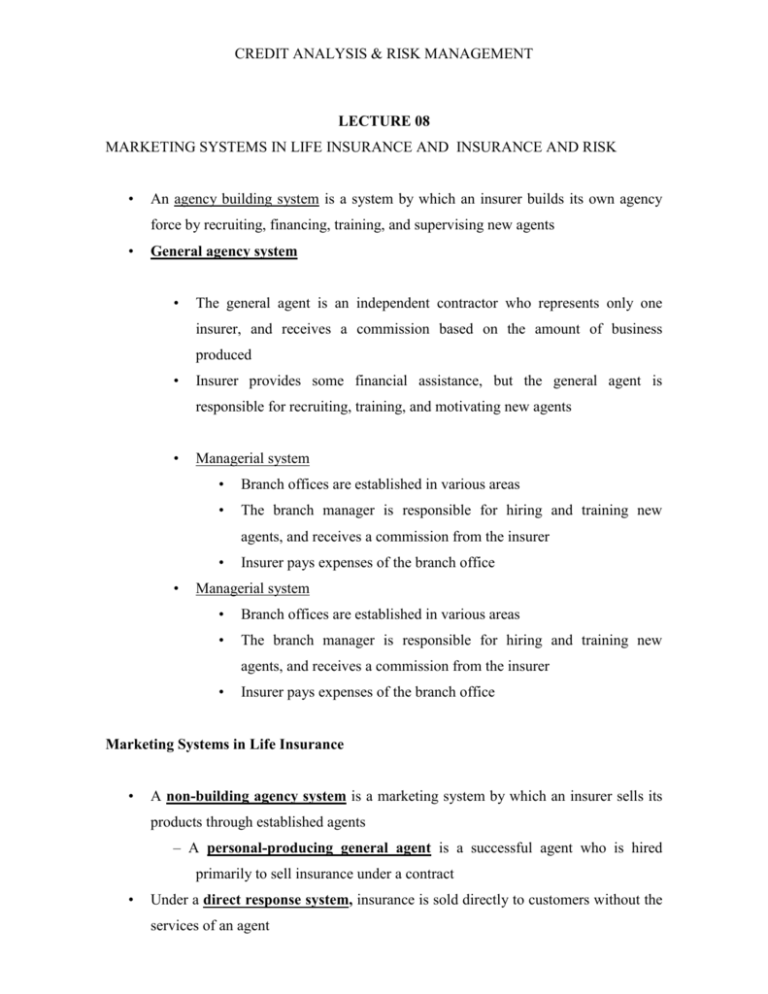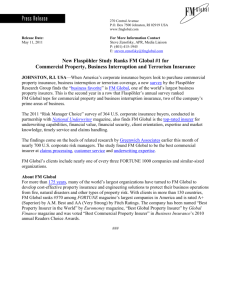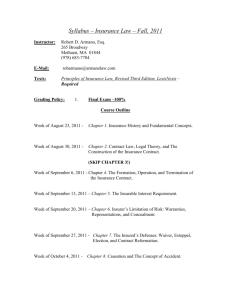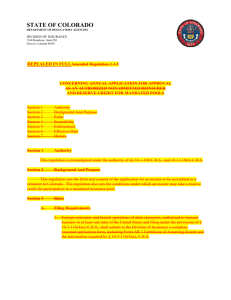CREDIT ANALYSIS & RISK MANAGEMENT
advertisement

CREDIT ANALYSIS & RISK MANAGEMENT LECTURE 08 MARKETING SYSTEMS IN LIFE INSURANCE AND INSURANCE AND RISK • An agency building system is a system by which an insurer builds its own agency force by recruiting, financing, training, and supervising new agents • General agency system • The general agent is an independent contractor who represents only one insurer, and receives a commission based on the amount of business produced • Insurer provides some financial assistance, but the general agent is responsible for recruiting, training, and motivating new agents • Managerial system • Branch offices are established in various areas • The branch manager is responsible for hiring and training new agents, and receives a commission from the insurer • • Insurer pays expenses of the branch office Managerial system • Branch offices are established in various areas • The branch manager is responsible for hiring and training new agents, and receives a commission from the insurer • Insurer pays expenses of the branch office Marketing Systems in Life Insurance • A non-building agency system is a marketing system by which an insurer sells its products through established agents – A personal-producing general agent is a successful agent who is hired primarily to sell insurance under a contract • Under a direct response system, insurance is sold directly to customers without the services of an agent CREDIT ANALYSIS & RISK MANAGEMENT Marketing Systems in Property and Liability Insurance • The independent agency is a business firm that usually represents several unrelated insurers – Agents are paid a commission based on the amount of business produced, which vary by the line of insurance – Agency owns the expirations or renewal rights to the business • Under the exclusive agency system, the agent represents only one insurer or group of insurers under common ownership – Agents do not usually own the expirations or renewal rights to the policies – Agents are generally paid a lower commission rate on renewal business than on new business Marketing Systems in Property and Liability Insurance • A direct writer is an insurer in which the salesperson is an employee of the insurer, not an independent contractor. – Employees are usually compensated on a “salary plus” arrangement • A direct response insurer sells directly to the consumer by television or some other media – Used primarily to sell personal lines of insurance • Many property and casualty insurers use multiple distribution systems Group Insurance Marketing • Many insurers use group marketing methods to sell individual insurance policies to: CREDIT ANALYSIS & RISK MANAGEMENT – Employer groups – Labor unions – Trade associations • Some property and liability insurers use mass merchandising plans to market their insurance • Employees pay for insurance by payroll deduction Insurance Company Operations Rate making • Rate making refers to the pricing of insurance – Total premiums charged must be adequate for paying all claims and expenses during the policy period – Rates and premiums are determined by an actuary, using the company’s past loss experience and industry statistics Underwriting • Underwriting refers to the process of selecting, classifying, and pricing applicants for insurance – The objective is to produce a profitable book of business • A statement of underwriting policy establishes policies that are consistent with the company’s objectives, such as – Acceptable classes of business – Amounts of insurance that can be written • A line underwriter makes daily decisions concerning the acceptance or rejection of business • There are three important principles of underwriting: CREDIT ANALYSIS & RISK MANAGEMENT – The underwriter must select prospective insureds according to the company’s underwriting standards – Underwriting should achieve a proper balance within each rate classification • In class underwriting, exposure units with similar loss-producing characteristics are grouped together and charged the same rate – Underwriting should maintain equity among the policyholders • Underwriting starts with the agent in the field • Information for underwriting comes from: – The application – The agent’s report – An inspection report – Physical inspection – A physical examination and attending physician’s report – MIB report • After reviewing the information, the underwriter can: – Accept the application – Accept the application subject to restrictions or modifications – Reject the application • Production refers to the sales and marketing activities of insurers – Agents are often referred to as producers – Life insurers have an agency or sales department – Property and liability insurers have marketing departments • An agent should be a competent professional with a high degree of technical knowledge in a particular area of insurance and who also places the needs of his or her clients first Claim Settlement • The objectives of claims settlement include: – Verification of a covered loss – Fair and prompt payment of claims CREDIT ANALYSIS & RISK MANAGEMENT – Personal assistance to the insured • Some laws prohibit unfair claims practices, such as: – Refusing to pay claims without conducting a reasonable investigation – Not attempting to provide prompt, fair, and equitable settlements – Offering lower settlements to compel insureds to institute lawsuits to recover amounts due • The claim process begins with a notice of loss • Next, the claim is investigated – A claims adjustor determines if a covered loss has occurred and the amount of the loss • The adjustor may require a proof of loss before the claim is paid • The adjustor decides if the claim should be paid or denied – Policy provisions address how disputes may be resolved Reinsurance • Reinsurance is an arrangement by which the primary insurer that initially writes the insurance transfers to another insurer part or all of the potential losses associated with such insurance – The primary insurer is the ceding company – The insurer that accepts the insurance from the ceding company is the reinsurer – The retention limit is the amount of insurance retained by the ceding company – The amount of insurance ceded to the re-insurer is known as a cession • Reinsurance is used to: – Increase underwriting capacity – Stabilize profits – Reduce the unearned premium reserve – The unearned premium reserve represents the unearned portion of gross CREDIT ANALYSIS & RISK MANAGEMENT premiums on all outstanding policies at the time of valuation – Provide protection against a catastrophic loss – Retire from business or from a line of insurance or territory – Obtain underwriting advice on a line for which the insurer has little experience • There are two principal forms of reinsurance: – Facultative reinsurance is an optional, case-by-case method that is used when the ceding company receives an application for insurance that exceeds its retention limit – Treaty reinsurance means the primary insurer has agreed to cede insurance to the reinsurer, and the reinsurer has agreed to accept the business • Under a quota-share treaty, the ceding insurer and the re-insurer agree to share premiums and losses based on some proportion • Under a surplus-share treaty, the re-insurer agrees to accept insurance in excess of the ceding insurer’s retention limit, up to some maximum amount • An excess-of-loss treaty is designed for catastrophic protection • A reinsurance pool is an organization of insurers that underwrites insurance on a joint basis Reinsurance Alternatives • Some insurers use the capital markets as an alternative to traditional reinsurance • Securitization of risk means that an insurable risk is transferred to the capital markets through the creation of a financial instrument, such as a futures contract • Catastrophe bonds are corporate bonds that permit the issuer of the bond to skip or reduce the interest payments if a catastrophic loss occurs Investments 1. Because premiums are paid in advance, they can be invested until needed to pay claims and expenses CREDIT ANALYSIS & RISK MANAGEMENT 2. Investment income is extremely important in reducing the cost of insurance to policy-owners and offsetting unfavorable underwriting experience 3. Life insurance contracts are long-term; thus, safety of principal is a primary consideration 4. In contrast to life insurance, property insurance contracts are short-term in nature, and claim payments can vary widely depending on catastrophic losses, inflation, medical costs, etc Other Insurance Company Functions 1. The electronic data processing area maintains information on premiums, claims, loss ratios, investments, and underwriting results. 2. The accounting department prepares financial statements and develops budgets. 3. In the legal department, attorneys are used in advanced underwriting and estate planning. 4. Property and liability insurers provide numerous loss control services.








